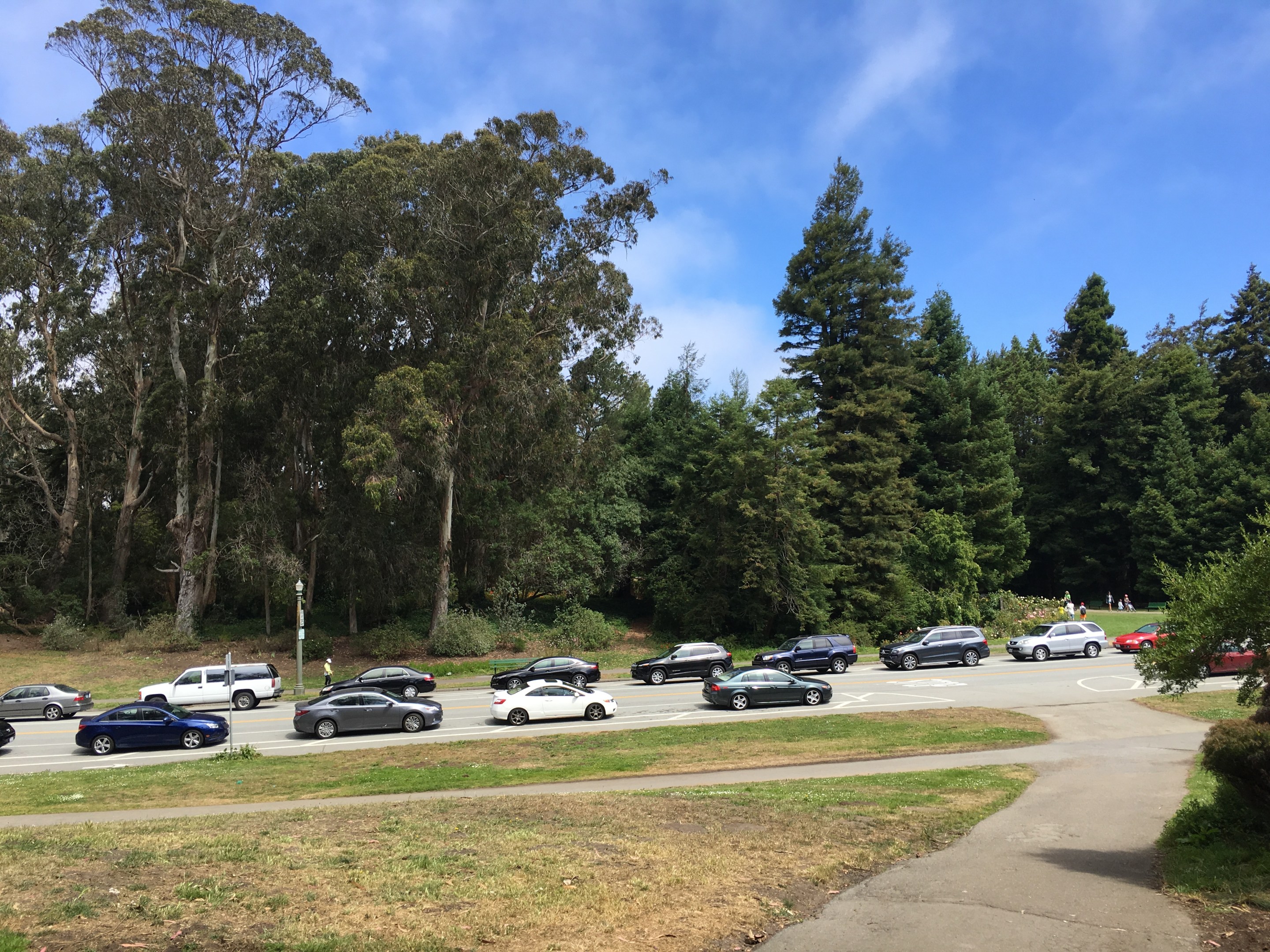Note: GJEL Accident Attorneys regularly sponsors coverage on Streetsblog San Francisco and Streetsblog California. Unless noted in the story, GJEL Accident Attorneys is not consulted for the content or editorial direction of the sponsored content.
Golden Gate Park is a verdant ribbon of trees, flowers, meadows, and lakes stretching from Stanyan Avenue to the Great Highway. While it was originally designed for recreation, escape, and solitude, today way too much of it is dedicated to driving and parking.
There are thirteen surface lots in the park. And if the hundreds of free spots within those lots aren't enough (or the paid lot under Cal Academy and the DeYoung Museum), there is also free street parking on nearly all sections of Arguello Boulevard, Chain of Lakes Drive, JFK Drive, and the other streets that cut through and around the park.

And yet, across the 1,000 acres of the park, there is not a single Class IV separated bike lane, or more plainly, one that has a complete physical barrier between it and car traffic.
Yes, there are some stretches of bike lanes of varying quality (parking protected bike lanes on JFK Drive, painted lanes on Conservatory Drive, and sharrows elsewhere), the fact remains that bicyclists are not prioritized. Neither are pedestrians or transit. Many roads include no sidewalks, leaving pedestrians (especially those with mobility impairments or strollers) to walk in bike or car lanes. In addition, five different SFMTA buses traverse the park at some point in their route (primarily on Crossover Drive), yet there are no bus-only lanes.
Meanwhile, we get standstill traffic (especially on weekends) while buses full of passengers languish behind all the cars and cyclists fight for space. A review of car-cyclist crash data from the California Highway Patrol from 2013-17 reveals several hotspots in Golden Gate Park, including at the corner of 19th Avenue and Lincoln Way as well as 30th Avenue and JFK Drive.
The good news is that Mayor Breed, the Board of Supervisors, SFMTA, and the Department of Parks and Recreation have options. They are as follows:
- Convert all currently free parking (in lots and on streets) to metered parking.
This approach maintains broad car access to the park, but at least puts a price on such travel. Metered parking would raise revenues that could be allocated to park improvements, and also encourage a higher rate of car turnover, which would theoretically create more open spots during peak hours and entail fewer cars circling for parking.
- Establish toll booths at all entrances to Golden Gate Park
Another option is rather than adding parking meters throughout the park, erect toll booths at each park entrance to put a price on entering by car. Again, revenues could be directed toward park improvements, and it would discourage motorists from driving through the park. Any amount of time near Stanyan Avenue on weekday evenings indicates this is a sizable component of park traffic, which degrades the quality of life in the park.
- Expand car-free days to more days of the week and more sections of Golden Gate Park
Currently, Golden Gate Park is car-free on Sundays year round (from Stanyan to Park Presidio), as well as Saturdays from April through September. An obvious way to encourage more sustainable travel to the park (and improve visitor experience and safety within it) is to expand the car-free portions of the week. Adding MLK Drive or the western half of JFK Drive as car-free sections, and making Saturday closures year round, would go a long way in giving the park back to people, particularly during peak usage.
- Ban cars from Golden Gate Park
The northern star for this campaign should be to ban cars completely from Golden Gate Park, 365 days a year. New York has already done this in Central Park. A ban on cars in Golden Gate Park is technically straightforward – install gates that can be opened for only a small handful of vehicles (park rangers, ambulances, public transit, etc.). This would transform the park into a haven for cyclists, roller-skaters, scooter riders, and pedestrians. It would create a precipitous drop in air and noise pollution, and re-affirm that public land in San Francisco can be used for so much more than private vehicle storage.
Central Park goes car free in June. 24/7, 365 days a year — because parks are for people, not cars. pic.twitter.com/kvRUgIudx1
— Mayor Eric Adams (@NYCMayor) April 20, 2018
It is not long ago that banning private cars from Market Street would have seemed unimaginable. The success of that social movement (and the recent SFMTA board vote) should galvanize us to consider what should come next in San Francisco’s transportation revolution.
Golden Gate Park’s time has come.
Marcel E. Moran is a PhD student in the Department of City and Regional Planning at UC Berkeley. He lives in San Francisco.





